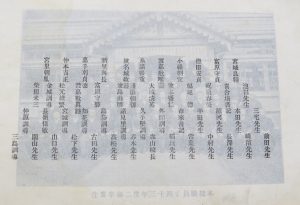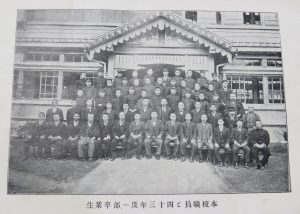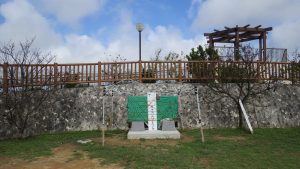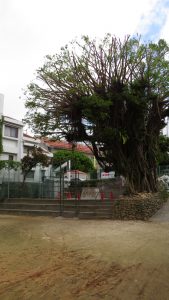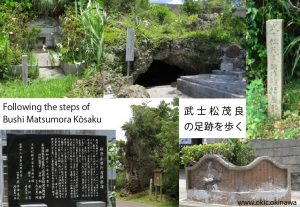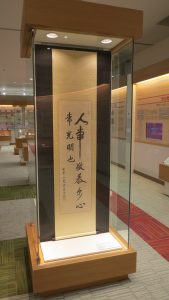Today, March 1st, the Okinawa karate promotion division sponsored “Okinawa Karate Academy” was held within the Okinawa Prefectural Government building. Approximately 30 people from the karate world participated.
The theme of this event, which was the third edition, was the “Re-examination of the Itosu Ankō photo - On the importance of backing up with contemporary historical documents”. Mr. Nakamura Akira, assistant curator at the Okinawa karate promotion division, was in charge of the examination. Today he announced the results of his investigation. Below is a summary of the contents of the announcement. Later on this website, we will introduce a feature article of the presentation.
In 2006, an article titled “Discovery of a photography of a legendary karate master” was published in the Okinawa Times. It was an article reporting the discovery of a photograph of Itosu Ankō (1831-1915), a man who left a huge footprint in Okinawa karate history. Since then, this photograph has been used widely as the photograph of Itosu Ankō. Yet, an examination work has been underway due the recent uncovering of new historical materials.
In the 2006 photograph, Tokuda Antei is present. Mr. Tokuda graduated in 1910 from the Okinawa Prefecture Junior High School (which later became Okinawa Prefectural 1st junior high school). Since the junior high school at that time was a 5 years system, the photo was taken between 1905 and 1910.
Through research and examination of historical documents of this same period, Mr. Nakamura discovered 2 pictures belonging to the Shihan Gakkō (Normal School) magazine “Ryūtan” No. 9. Published in 1911, this document is preserved in the Library of the University of the Ryūkyūs.
Below is one of the two photograhs discovered. It is titled "Our school staff and some graduates of year 43 (1910)". The material to the left is the picture with a tracing paper on which are listed the names of all persons in the photograph. The one to the right is the actual picture. These materials are property of the Library of the University of the Ryūkyūs.
In these photographs, standing to the right end of the second row, the person who was thought to be Itosu Ankō is introduced. However, on the other page's list of names, he is introduced as “Miyake sensei”.
The man believed to be Itosu Ankō until now is actually a Shizoku (descendant of a samurai) from Miyazaki prefecture. Born in 1847, his name is Miyake Sango. He served as a fencing instructor of the Okinawa police while also teaching fencing at the Okinawa Prefecture Normal School and the Okinawa Prefecture Junior High School (later nicknamed Icchū).
Now, looking at the 2006 picture, it is clear that it is not the full version of a group photograph.
The 2006 photo was obtained from the album book of Tokuda Antei by Arasaki Seibin. Mr. Arasaki left a testimony saying “In this group is Ishiji (Itosu) no Tanmē (old man)”. Perhaps Itosu appears in the lost part of the picture…?
Undeniably, the search for solving this mystery will be the source of much passionate debate among karate enthusiasts.
Note: This article is being posted under the supervision of Okinawa karate promotion division.
On the eve of the First Okinawa karate international tournament, Shurite & Shōrin-ryū will be honored on July 28th and 29th.
This year marks the 232nd anniversary of Sakugawa Kanga, a master known as Tōdē Sakugawa. Born in Shuri, he is remembered for creating the bō - staff kata Sakugawa no kun.
On Saturday July 28th, led by Nakamoto Masahiro sensei, holder of the Okinawa prefecture-designated intangible cultural asset “karate & kobudō”, the monument honoring the land where originated Shurite karate and kobudō will be unveiled. The venue is Sakiyama Park in Shuri, Naha City. The unveiling ceremony will be held at 11 am. After the unveiling ceremony, a celebration, karate demonstrations and hatagashira - flag poles performances are scheduled.
On Sunday July 29th, led by the chairman of the Okinawa Shōrin-ryū (Kobayashi-ryū) Karatedō Association Miyagi Takeshi sensei, a monument praising the founder of the style Shōrin-ryū Chibana Chōshin sensei will be unveiled. The venue of the ceremony is the community hall square of Shuri Yamakawa in Naha city. The ceremony is scheduled for 10:00 to 12:00.
(Left, the monument in Sakiyama Park. Right, the square of the Yamakawa community hall)
During the Ryūkyū Kingdom, Tomari was a port city involved with the foreign trade of the Shuri court. It was the entrance for foreign visitors and the culture they brought. Along the way, the area became the birthplace of many experts in the fields of Chinese classics, performing arts, music, martial arts among others.
It is said that Tomari’s temple Seigenji, commonly known as Ameku’s temple, was the base of activities of foreigners who disembarked in Tomari port. Among these were drifted ashore Chinese and Korean merchants. Tomari people were instructed in martial arts by these foreigners, which later gave birth to Tomarite, a martial art differing from the martial arts of Shuri and Naha.
Tomarite is said to have started with Teruya Kishin (1804-1864) and Uku Karyū (1800-1850). The one who inherited their art was Matsumora Kōsaku (1829-1898). He is considered as the one who rejuvenated Tomarite.
Today, there are at least 6 sites in the Okinawa prefecture that are landmarks in regard to the Tomari master’s legacy.
The most famous is indeed the praising monument located in the Shinyashiki Park. Raised in May 1983, it is located between Route 58 and the Tomari international cemetery.
Close-by, near the Tomari temple of Seigenji is the Kāmi-nu-yā cave where Matsumora Kōsaku is said to have train with a man who lived there.
A passage about this cave can be found in the 1970 published book "Karate (Tomarite) Chukō no So, Matsumora Kōsaku Ryakuden" (1) by Matsumura Kōshō. Previously named Matsumora, the author is the grandchild of Matsumora Kōsaku.
It is said that after receiving instruction in karate from Uku Karyū and Teruya Kishin, “Kōsaku went to ask for karate instruction to a Chinese who lived in a cave called ‘Kāmi-nu-yā’ on the shore of Tomari (although according to another version, it was a Ryūkyū man who hid from the royal government and thus dressed as a Chinese; anyway, the truth is unknown). At first, his request was refused but due to Kōsaku’s ardent desire, he received instruction…”
The third monument in Naha is located close by the Tomari elementary school and is known as the Bushi Matsumora relief sculpture.
Next to these three monuments and sites, there are 3 other sites that relates to the master.
One of them is the Fērē rock in Onna Village where Matsumora subdued some bandits.
A second one mentioned on the monument raised in Shinyashiki Park and in Matsumura’s book is the master’s retreat in northern Okinawa. Finally, Matsumora’s tomb is located in Onna Village.
Mainly remembered as a martial expert, Matsumora Kōsaku actually personifies a true Okinawan Bushi, meaning that next to having acquired great martial skills, he also contributed to the society. An example of his contribution is inscribed on the monument as follow.
“In the past in Tomari Village, in addition to community property received from the Ryūkyū royal administration, existed a common property called ‘Nēwagumuchi’. It was donated for the welfare of Tomari villagers by Yamazato Chōken, who passed the royal government examination and became a government official (2).
When came the abolition of feudal domains and establishment of Okinawa Prefecture in 1879, Japanese government officials planned a policy to pull up this fortune. However, at the risk of his life, the bujin of Tomari Matsumora Kōsaku demonstrated his strong spirit and the project was abandoned. Today still, the donation is utilized as funding for the Tomari Senkaku Kenshōkai, the Tomari Pioneers Praising Association. We hand to posterity the name of the fist saint Matsumora, a man who persisted in the path of crushing evil and spreading the true.”
(1) The title could be translated as “Short biography of the rejuvenator of Tomarite Karate, Matsumora Kōsaku”.
(2) Born in a poor family, Yamazato Chōken (1820-1893) raised to become a royal clerk. It is said that after passing the royal examination, he gave a huge sum of money to Tomari that was to be used for the education of local nobles.
Sources: Karatedō and kobudō preliminary survey report, Okinawa Prefecture Board of Education, Matsumura Kōkatsu’ s "Bushi Matsumora Kōsaku Ryakuden" (published in 1970)
In the Archives of the Okinawa Karate Kaikan is exhibited a brushwork once calligraphed by late Matsumura Sōkon, the great karate master.
The sentence composed of 10 characters was once introduced in Miyagi Tokumasa’s book “Karate No Rekishi” published in 1987 by Okinawa Bunko. The piece exhibited in the Archives is a replica of the original.
It seems that this phrase was taken from the “Zhuzi yulei”, a collection of conversations relating to neo-Confucian scholar Zhu Xi.
In his book, Miyagi Tokumasa wrote “Bushi Matsumura is known as a Bujin who also excelled in Bunbu Ryōdō, scholarship and the martial arts. The brushwork hereby appearing is a good and suitable material to prove this fact. The phrase reads as ‘Hito, tsuneni keikyō nareba, sunawachi kokoro wa tsuneni kōmyō nari’ (1). It was written by Sōkon when he was 76 years old of age. From the strength of the brush work and the phrases, it is indeed the artwork of a Bujin.”
In this splendid calligraphy by Matsumura Sōkon who adopted the calligrapher name “Unyū” and was also called “Buchō” the head of martial arts, the second character on the right from top reading “常 - Tsune” or always is particularly beautifully written. The viewer can easily imagine a revolving sai, the trident of kobudō or an ornamental hairpin called jīfā in Okinawa.
Do not miss to visit the Okinawa Karate Kaikan to admire the calligraphy of Matsumura Sōkon, a man who is considered as one of the “Chūkō no so (2)” of karate.
(1) One translation could be: If one is always respectful, that is the heart will always be bright.
(2) Chūkō no so: There are 3 masters considered as the rejuvenators of karate: Matsumura Sōkon (Shurite), Matsumora Kōsaku (Tomarite) and Higaonna Kanryō (Nahate).
Photo credit: Okinawa Prefecture Karate Promotion Division – Okinawa Karate Kaikan
